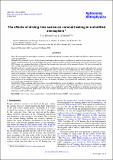The effects of driving time scales on coronal heating in a stratified atmosphere
Date
24/05/2022Funder
Grant ID
647214
ST/W001195/1
ST/S000402/1
Keywords
Metadata
Show full item recordAbstract
Aims: We investigate the atmospheric response to coronal heating driven by random flows with different characteristic time scales and amplitudes. Methods: We conducted a series of 3D MHD simulations of random driving imposed on a gravitationally stratified model of the solar atmosphere. In order to understand differences between alternating current (AC) and direct current (DC) heating, we considered the effects of changing the characteristic time scales of the imposed velocities. We also investigated the effects of the magnitude of the velocity driving. Results: In all cases, complex foot point motions lead to a proliferation of current sheets and energy dissipation throughout the corona. For a given amplitude, DC driving typically leads to a greater rate of energy injection when compared to AC driving. This leads to the formation of larger currents, increased heating rates and higher temperatures in DC simulations. There is no difference in the spatial distribution of energy dissipation across simulations, however, energy release events in AC cases tend to be more frequent and last for less time than in DC cases. Higher velocity driving is associated with larger currents, higher temperatures and the corona occupying a larger fraction of the simulation volume. In all cases, most of heating is associated with small energy release events, which occur much more frequently than large events. Conclusions: When combined with observational results showing a greater abundance of power in low frequency modes, these findings suggest that energy release in the corona is likely to be driven by longer time scale motions. In the corona, AC and DC driving occur concurrently and their effects remain difficult to isolate. The distribution of field line temperatures and the asymmetry of temperature profiles may reveal the frequency and longevity of energy release events and therefore the relative importance of AC and DC heating.
Citation
Howson , T A & De Moortel , I 2022 , ' The effects of driving time scales on coronal heating in a stratified atmosphere ' , Astronomy & Astrophysics , vol. 661 , A144 . https://doi.org/10.1051/0004-6361/202142872
Publication
Astronomy & Astrophysics
Status
Peer reviewed
ISSN
0004-6361Type
Journal article
Description
Funding: The research leading to these results has received funding from the UK Science and Technology Facilities Council (consolidated grant ST/N000609/1), the European Union Horizon 2020 research and innovation programme (grant agreement No. 647214). IDM received funding from the Research Council of Norway through its Centres of Excellence scheme, project number 262622. This work used the DiRAC Data Analytic system at the University of Cambridge, operated by the University of Cambridge High Performance Computing Service on behalf of the STFC DiRAC HPC Facility (www.dirac.ac.uk). This equipment was funded by BIS National E-infrastructure capital grant (ST/K001590/1), STFC capital grants ST/H008861/1 and ST/H00887X/1, and STFC DiRAC Operations grant ST/K00333X/1. DiRAC is part of the National e-Infrastructure.Collections
Items in the St Andrews Research Repository are protected by copyright, with all rights reserved, unless otherwise indicated.

